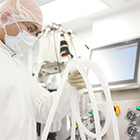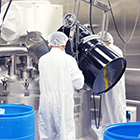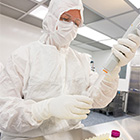Upstream Gene Therapy Products & Solutions in Bioprocessing
Achieve optimal generation of gene therapy vectors with our non-viral transfection and viral transduction products. Avantor® can provide culture systems that support processes development, scale-up and full manufacturing.
Our systems include a wide variety of gene therapy bioprocessing products, including:
- Transfection and electroporation products
- Chemicals, buffers, salts, and reagents
- Viral vector generation kits
- Seradigm animal sera (e.g., FBS)
- Single-use products
- Sterile cell factories
Explore Solutions for Upstream Gene Therapy Processing
At Avantor®, you'll find the gene therapy bioprocessing products you need to conduct efficient upstream bioprocessing for gene therapy. From single-use solution products to viral vector generation kits, we carry top brands to help ensure your gene therapy bioprocessing solutions meet your manufacturing needs, whether for clinical, research, or manufacturing scale.
Gene Therapy Bioprocessing Solutions for Discovery, Product Development & Pre-Clinical (Mammalian)
Gene Therapy Bioprocessing Products for Scale-Up & Production (Mammalian)
Upstream Processing Gene Therapy Products for Discovery, Product Development & Pre-Clinical (Microbial)
Gene Therapy Upstream Bioprocessing Products for Scale-Up & Production (Microbial)
Viral Vector Characterization
Ready to Get Started?

Ready to Maximize Production Efficiency?
Our Bioprocessing Solutions team can help you streamline your biomanufacturing processes!
What is a Gene Therapy Viral Vector?
A gene therapy viral vector is a virus that has been modified to deliver therapeutic encoded genes, regulatory RNAs, or other substrates to cells. Specific DNA sequences are designed and synthesized in a laboratory to target specific cells. Modified viruses are an excellent vector to deliver these sequences because viruses can enter cells, including hard-to-reach specific cells. Using viral vectors for gene therapy makes it possible to modify gene expression by programming the cells with targeted genetic material.
Upstream bioprocessing for gene therapy typically uses transient or stable transfection to produce viral vectors. Both methods have advantages and disadvantages, so selecting the optimal vector manufacturing process for the specific dose and patient population is important.
What Is the Difference Between Gene and Cell Therapy?
The difference between gene and cell therapy is that gene therapy involves using a carrier, or vector, to transfer genetic material. The genetic material is inserted into the genome of targeted cells in the body.
In comparison, cell therapy involves introducing or injecting cells that function as desired into the patient's body. Cells may come from the patient (autologous cells) or a donor (allogeneic cells) and are expanded and/or modified before injecting them. Genetic modification, for example to produce CAR T-cell therapies or a modified stem cell therapy, can be achieved using viral vectors, mRNA or gene editing technologies like CRIPSR.Both gene and cell therapies improve body functions, but only gene therapy alters the patient's cellular genetics.
Another difference between gene and cell therapy is in bioprocessing. Gene therapy can be easier to manufacture at larger scales when compared to cell therapy. One reason is that gene therapy upstream bioprocessing is comparable to recombinant manufacturing. Cell therapy bioprocessing remains manual and requires customization that limits its manufacturing capacities.
Ready to Get Started?
Our Bioprocessing Solutions team can help! We offer upstream support for all areas, including cell culture, cell banking, and onsite media/buffer preparation. Let us reduce the burden of routine tasks and improve the productivity of your gene therapy endeavors.



